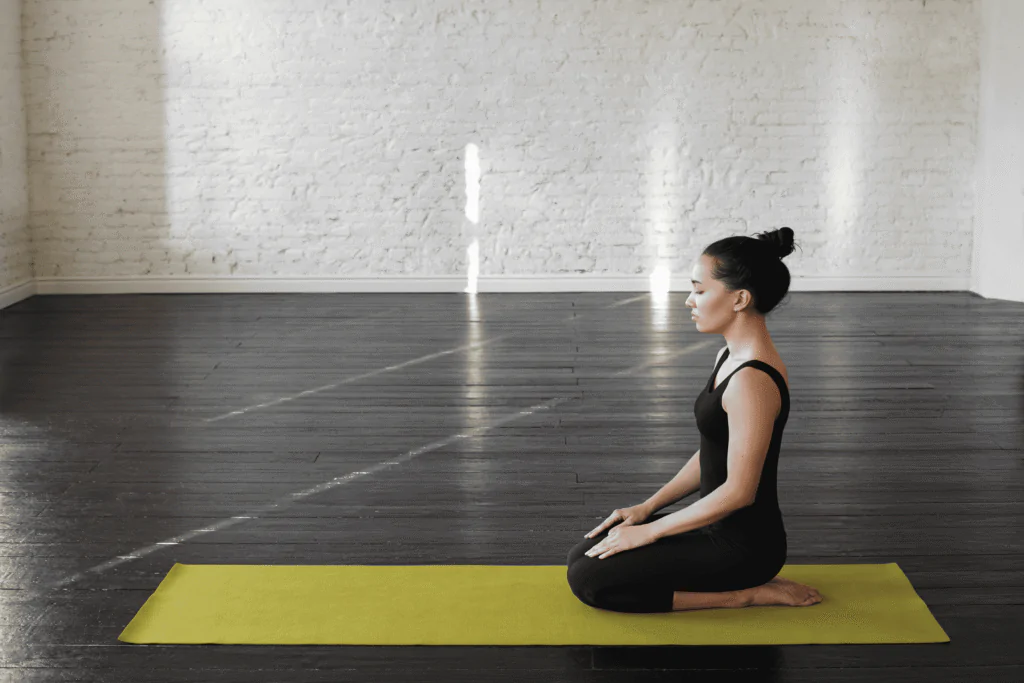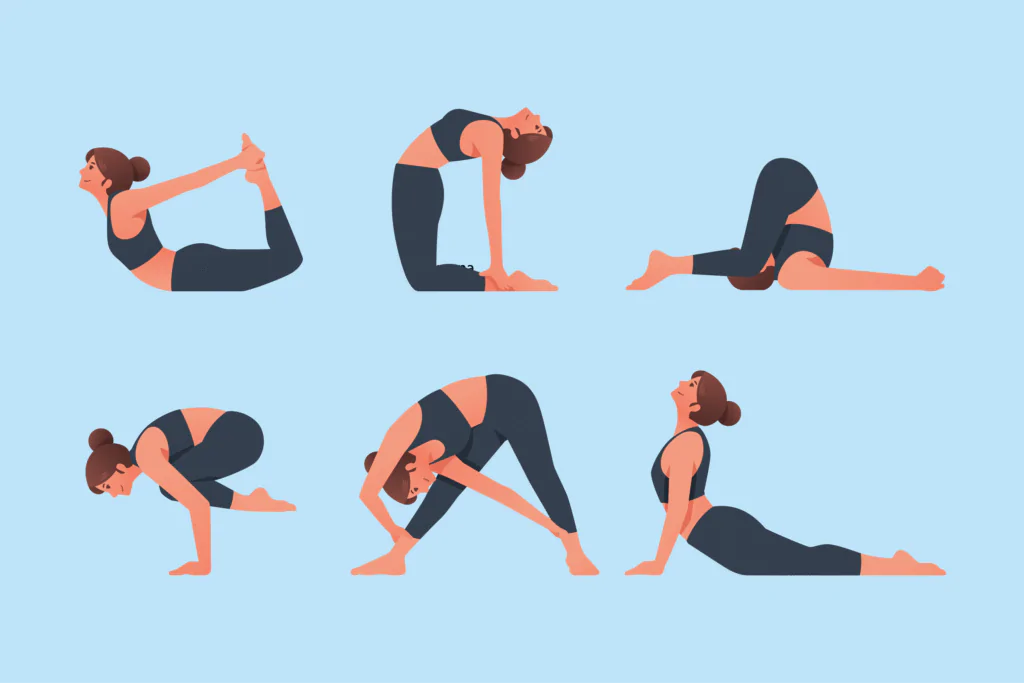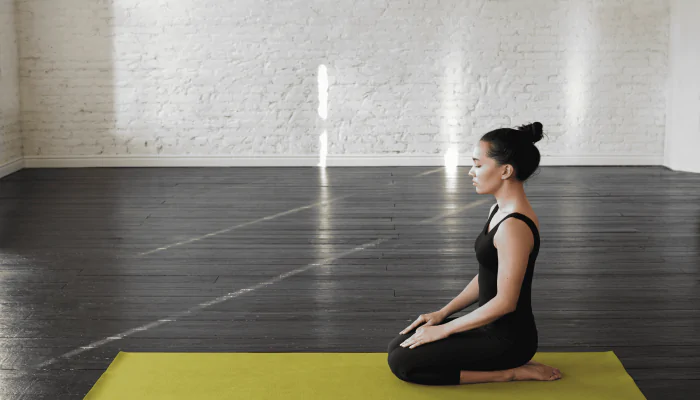What is Vajrasana Pose?
Vajrasana, often called the Thunderbolt Pose or Diamond Pose, is a kneeling meditation position that has been practiced for centuries in yoga and mindfulness traditions. Unlike most seated poses that are done with crossed legs, Vajrasana has you sit on your heels with your knees bent and your shins resting on the ground.
This posture is unique because it’s one of the very few meditation poses that can be comfortably practiced right after eating. In fact, many people in India and Japan traditionally sit like this after meals to help digestion. If Lotus or Burmese feels too challenging, Vajrasana gives you another simple yet powerful way to sit still, focus, and breathe.
How to Perform the Vajrasana Pose?
- Kneel down on a mat with your knees close together and your shins flat on the floor.
- Place your feet so the tops are resting on the ground, big toes touching.
- Gently lower your hips and sit back onto your heels.
- Rest your hands on your thighs, palms facing down.
- Keep your back straight, chin slightly tucked, and shoulders relaxed.
- Close your eyes and begin focusing on your breath.

Tip: If it feels too intense on your ankles or knees, you can place a folded blanket between your thighs and calves for support.
What are the Mental and Physical Benefits of Vajrasana Pose?
- Improves digestion: Sitting in this posture helps blood flow to the stomach and intestines, making it perfect after meals.
- Relieves bloating: The gentle pressure on the belly can reduce gas and discomfort.
- Boosts focus and calmness: The upright spine supports alertness while calming the mind.
- Strengthens lower body: Regular practice improves flexibility in the thighs, knees, and ankles.
- Reduces anxiety: Sitting still in Vajrasana creates a sense of stability and grounding, which eases stress.
What are the Variations of Vajrasana Pose?
- Supta Vajrasana (Reclined Thunderbolt Pose): Recline backward while staying in Vajrasana, lying on the floor for a deep stretch.
- Parvatasana in Vajrasana (Mountain Pose in Thunderbolt): Extend arms overhead with palms pressed together to add a chest and shoulder stretch.
- Dynamic Vajrasana: Stay seated but focus on breath or add mudras for a calming effect.

What are the Preparative Poses ?
Before you settle into Vajrasana, it helps to warm up your legs and back with:
- Cat-Cow Stretch – to mobilise the spine.
- Hero Pose (Virasana) – to open thighs and knees.
- Child’s Pose (Balasana) – to gently prepare the body for sitting.
What is the Anatomy of Diamond Pose?
In Vajrasana, the skeletal and muscular systems work together to create stability and alignment:
- Knees & Ankles: The weight of the body rests mainly on the knees and ankles, requiring flexibility in these joints.
- Thighs & Calves: The quadriceps and calf muscles stretch while supporting the posture.
- Spine: The back stays upright, activating the erector spinae muscles for proper alignment.
- Pelvis: The pelvis is slightly tilted, grounding the body and improving balance.
- Core: Gentle activation of abdominal muscles keeps the torso lifted and prevents slouching.
This anatomical setup makes Vajrasana a pose of stillness and grounding, yet it quietly engages the body.
How to Figure Out if Thunderbolt Pose is the Right Pose for You?
Here are some questions to help you decide:
- Do you struggle with crossed-leg postures? If sitting in Lotus or Burmese feels painful, Vajrasana may be a better fit.
- Do you often feel bloated after eating? Vajrasana is especially supportive for digestion.
- Do your knees or ankles hurt in this position? If yes, it might not be suitable unless you use props for support.
- Do you want a short, beginner-friendly meditation? Vajrasana is easy to practice for 5–10 minutes without straining.
- Are you aiming for posture and mental alertness? The upright spine in Vajrasana keeps you calm yet attentive.

If you feel mild discomfort, try a cushion or a folded blanket. If you feel sharp pain in the knees or ankles, switch to another meditation pose like Sukhasana or Burmese.
What are the Precautions?
- Avoid if you have serious knee or ankle injuries.
- Don’t force yourself into the pose; use props for support.
- If you feel tingling or numbness in your legs, come out of the posture slowly.
- Always keep your spine straight—slouching can strain your lower back.
Conclusion
Vajrasana may look simple—just sitting on your heels—but anyone who has tried it knows it carries its own kind of challenge and beauty. This posture grounds you, straightens your spine, and brings your mind into a quiet state of awareness. It’s not about flexibility or pushing your body; it’s about finding stability and stillness while staying alert.
If you’re someone who struggles with crossed-leg positions like Lotus or Burmese, Vajrasana can be a wonderful alternative. And if you want a pose that actually supports digestion and calmness after meals, this is one of the best choices you can make.

